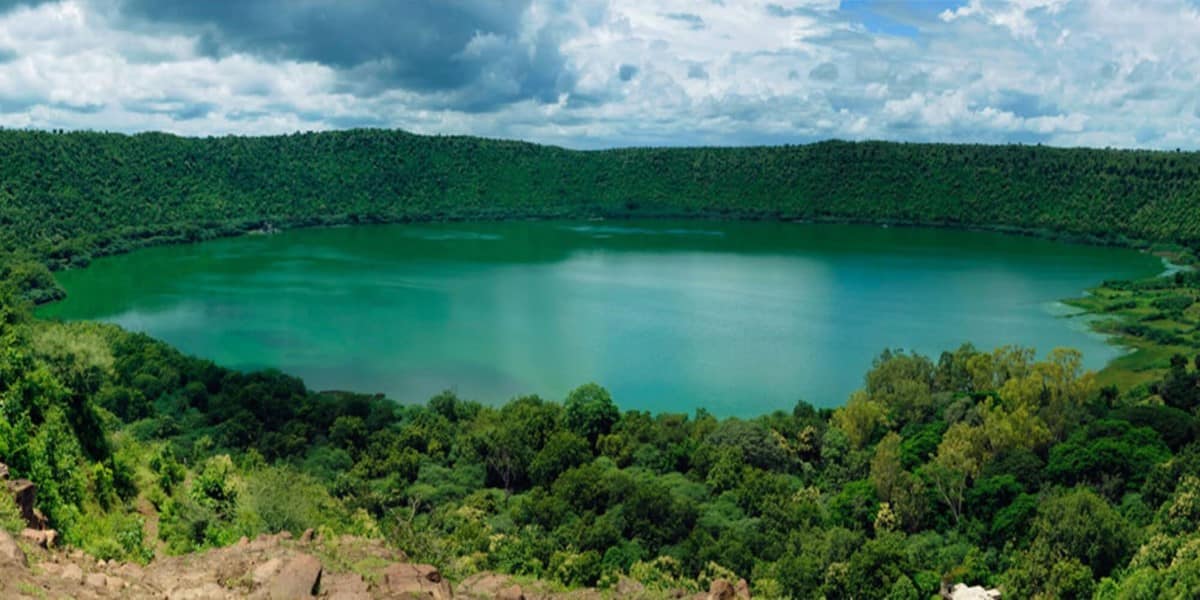Lonar Lake
Doodlebrary
- Lonar Crater Lake is a lagoon lake in Buldhana district of Maharashtra state.
- It was made out of meteorite.
- Its has alkaline water.
- Lonar Lake has been regarded as Wildlife Sanctuary.
- There are some temples situated which are made around 1250 years ago.
- Among them, 15 temples are in reversal.
- It is believed that the lonar lake is formatted about 52,000 ± 6,000 years ago.
- But by a research paper published in 2010, we came to know that the age of the lake is approximately 570,000 ± 47,000 years.
- The lake is situated on the planet’s just high speed sway shaped in basaltic stone.
- According to researchers, the pit was framed after a comet or a space rock hit the region at a speed of 90000 km for each hour.
- It is found 370kms/9 hours east of Mumbai.
- The lake’s mean measurement is around 3900 ft or 1.2 km, and the distance across of the crater on which the lake sits is 1.8 km.
- The carter on which the lake sits is oval fit as a fiddle demonstrating that the comet or space rock hit the spot at an edge of 35 to 40 degrees.
- You won’t locate any sort of vegetation in the mud belt, which is because of the soluble substance of the region.
- If you go toward the southern finish of the lake, there is a sweet water well. At that point there are two streams that resemble water hotspot for the lake as these streams stream go straight into the lake.
- The biological system of the lake is surprising that there are two unmistakable water districts in the lake that don’t blend in with one another.
- The external area of the lake is unbiased locale that has a pH level of 7.
- The lake’s internal locale is the antacid part that has a pH level of 11. Both the districts are novel and houses differing widely varied vegetation.
- The most unmistakable reptiles found in the Lonar Crater Lake are the screen reptiles.
- Another component of this lake is the non-cooperative nitrogen fixing microorganisms, for example, Klebsiella sp. Slackia sp. Paracoccus sp. Actinopolyspora sp., and Halomonas sp.
- According to contemplates, it has been uncovered that every one of these organisms can live just in basic conditions and that too with a pH level of 11.
- Lonar is a community in Buldhana area of Maharashtra, about 140kms/4 hours east of Aurangabad.
- It is found 370kms/9 hours east of Mumbai.
- Aurangabad is the nearest air terminal to Lonar, with immediate, day by day flights from Delhi and Mumbai.
- In excess of 20 trains run among Mumbai and Aurangabad by Manmad Junction.
- The focal transport remain in Aurangabad is about 1km from the train station.
- Transports to Lonar employ through Jalna and take around 5 hours.
- MSRTC, Shivneri and private buses run whole night from Mumbai to Aurangabad (₹650 for non AC, ₹750 for AC sleeper). You can hire cabs also from Aurangabad.
- Walk to May are the most sweltering a long time in Maharashtra, and temperatures can climb as much as 40°C.
- Intermittent rainstorms in any case, give break from the warmth.
- Winter (Oct-Feb) is mellow, with clear skies, delicate breezes and normal daytime temperatures that go between 12-25°C.
- Rainstorm start in June and can go on up to September.
- The most extreme measure of precipitation is normal in July.
- Lonar’s primary fascination is the lake and the sanctuaries that encompass it.
- Aurangabad city, 140km away, has a few notable landmarks, for example, Bibi ka Maqbara, the oft-disregarded Aurangabad caverns and the medieval watermill Panchakki.
- Inside Aurangabad locale are the UNESCO World Heritage caverns of Ajanta and Ellora; Daulatabad, otherwise called Deogiri, the renowned capital city set up by Mohammad receptacle Tughlaq; Khuldabad, otherwise called the Valley of Saints; the well known Grishneshwar sanctuary; and the Pitalkhora caverns.
- Guides charge is like ₹800 for the afternoon, and are justified, despite all the trouble.
- Wear great strolling shoes and convey drinking water, sunscreen, creepy crawly repellent, a top, shades and snappy dry garments.
- There are dhabas and tea slows down at Lonar, and the sanctuaries have consumable water. There’s an ATM close to the bus stop.
